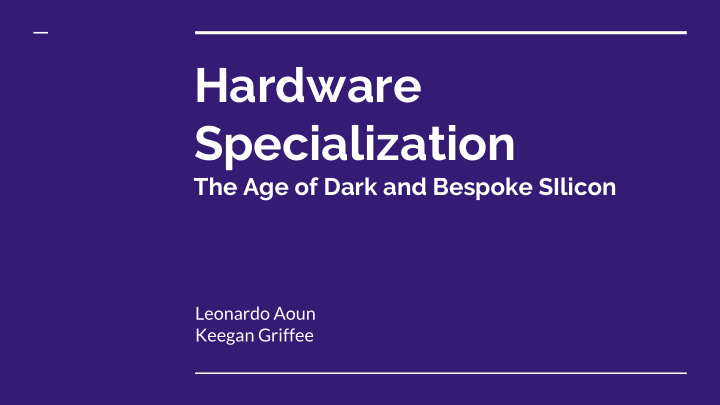



Hardware Specialization The Age of Dark and Bespoke SIlicon Leonardo Aoun Keegan Griffee
Dark Silicon • What: Silicon that is not used all the time or at its full frequency • Why: Transistor energy efficiency improves at a slower rate than the improvements of native transistor speeds and transistor density • Dark Silicon on chip is exponentially increasing • PANIC ------- THE APOCALYPSE APPROACHES
The Four Horsemen of the Apocalypse
The Shrinking Horseman - Building smaller chips - Price:Size ratio goes higher the smaller the chips get - Same goes for Temperature - Most pessimistic Horseman
The Dim Horseman - Implemented: - Manipulates: - Turbo Boost - Voltage 1.0 - Frequency - NTV - Duty cycles Processors To manage power - Bigger caches
The Specialized Horseman - Power and clock-gate unused cores - reduce the amount of capacitance per particular operation � for coprocessors � for general-purpose
The Specialized Horseman � for coprocessors � for general-purpose => Tower of Babel Problem
The Deus Ex Machina Horseman - Hope for a breakthrough in semiconductor devices - MOSFET-imposed limits - Currently at a bottleneck imposed by the laws of physics - Alternatives to MOSFET transistors - Tunnel Field-Effect Transistors (TFETs) - Nanoelectromechanical System (NEMS) - Beyond-CMOS approaches - Electron-Spin Memory (C-SPIN) - Statistics Models: Nondeterministic (SONIC)
So what? - Decrease sharing - Expensive control logic - Additional energy consumption - Reduce pipelining - Increases duty cycle and increases capacitance - Increases gap between processing and memory
Bitcoin • International Cryptocurrency (Began Jan 3 rd , 2009) • Account that allows you to make or receive payments • System maintains a global, distributed cryptographic ledger of transactions called the blockchain • Maintained by computers running a consensus algorithm across the world • Algorithm is called mining- integrates transactions into the blockchain • Each transaction becomes the new head block and is posted to the block chain
Why Mine • Each block the miner adds to the block chain: • Block Reward (Started at 50 BTC, halved every 210,000 blocks) • BTC cannot exceed 21 million • In 2032, 99% will be issues • Rewarded transaction fees attached to the block • The higher the transaction fee the faster the transaction is completed • Incentivizes paying to use the service
Why Use Bitcoin •Can be used internationally •Known upper limit to amount of BTC that can be mined •Users are mostly anonymous and transactions are secure but public to everyone • Can still be traced and subjected to law enforcement
Bitcoin Trend • Difficulty of mining is dynamically increased as more machines mine to avoid saturating the amount of currency created per day
Bitcoin Stats: May 14th 2017 •1 BTC = 1,825.40 Dollars •Current Block Reward = 12 BTC = 21,904.80 Dollars •Bitcoin Mined = 77.76% •Total BTC in circulation: 16,330,450 •Total BTC left to mine: 4,669,550 •Sources •http://www.coindesk.com/price/ •http://www.bitcoinblockhalf.com/
Bitcoin, Bespoke and Dark Silicon • Cost of cooling and energy is what holds back miners • Bespoke Silicon • Best if the specialized implementation is much smaller than the general purpose case and computation exhibits weak scaling • The power of homebrew and crowdsourcing
Thanks for Listening!
Article Sources https://cseweb.ucsd.edu/~mbtaylor/papers/bitcoin_tayl ● or_cases_2013.pdf http://cseweb.ucsd.edu/~mbtaylor/papers/taylor_landsc ● ape_ds_ieee_micro_2013.pdf
Recommend
More recommend